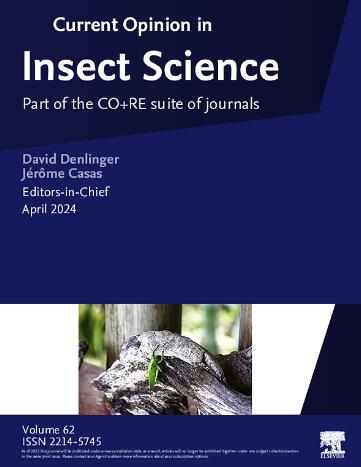气候变化和空气污染对挥发性物质介导的植物寄生虫信号的挑战。
IF 5.8
1区 农林科学
Q1 BIOLOGY
引用次数: 0
摘要
食草动物诱导的植物挥发性物质(HIPVs)是寄生虫用来定位寄主斑块的可靠线索。由植物挥发性有机化合物(VOCs)介导的相互作用很容易受到预测的气候变化和空气污染情景的干扰。非生物压力引起的挥发性有机化合物可能会成为寄生虫的错误信号。空气污染物会以不同的速度降解 HIPVs,并通过降低嗅觉受体的灵敏度或闭塞昆虫的感觉器来阻止对嗅觉信号的感知,从而破坏信号传递。作为生物防治计划的重要组成部分,应努力评估不同寄生物种在预测的情况下如何应对和适应 HIPVs。由于提供寄生虫食物来源是促进生物防治的一种有前途的做法,寄生虫与花卉之间的相互作用值得关注。本文章由计算机程序翻译,如有差异,请以英文原文为准。
Challenges of climate change and air pollution for volatile-mediated plant–parasitoid signalling
Herbivore-induced plant volatiles (HIPVs) are reliable cues that parasitoids can use to locate host patches. Interactions mediated by plant volatile organic compounds (VOCs) are vulnerable to disturbance by predicted climate change and air pollution scenarios. Abiotic stress–induced VOCs may act as false signals to parasitoids. Air pollutants can disrupt signalling by degrading HIPVs at different rates and preventing the perception of olfactory signals by reducing the sensitivity of olfactory receptors or by occluding insect sensillae. As essential components of biological control programmes, efforts should be made to assess how different parasitoid species respond and adapt to HIPVs in predicted scenarios. Since providing parasitoid food sources is a promising practice for boosting biological control, parasitoid–flower interactions deserve attention.
求助全文
通过发布文献求助,成功后即可免费获取论文全文。
去求助
来源期刊

Current opinion in insect science
BIOLOGYECOLOGYENTOMOLOGY-ECOLOGY
CiteScore
10.40
自引率
1.90%
发文量
113
期刊介绍:
Current Opinion in Insect Science is a new systematic review journal that aims to provide specialists with a unique and educational platform to keep up–to–date with the expanding volume of information published in the field of Insect Science. As this is such a broad discipline, we have determined themed sections each of which is reviewed once a year.
The following 11 areas are covered by Current Opinion in Insect Science.
-Ecology
-Insect genomics
-Global Change Biology
-Molecular Physiology (Including Immunity)
-Pests and Resistance
-Parasites, Parasitoids and Biological Control
-Behavioural Ecology
-Development and Regulation
-Social Insects
-Neuroscience
-Vectors and Medical and Veterinary Entomology
There is also a section that changes every year to reflect hot topics in the field.
Section Editors, who are major authorities in their area, are appointed by the Editors of the journal. They divide their section into a number of topics, ensuring that the field is comprehensively covered and that all issues of current importance are emphasized. Section Editors commission articles from leading scientists on each topic that they have selected and the commissioned authors write short review articles in which they present recent developments in their subject, emphasizing the aspects that, in their opinion, are most important. In addition, they provide short annotations to the papers that they consider to be most interesting from all those published in their topic over the previous year.
 求助内容:
求助内容: 应助结果提醒方式:
应助结果提醒方式:


